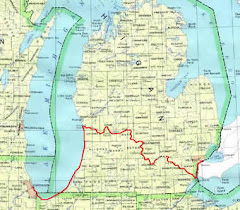Wikipedia: "The Churchill River is a major river in Saskattchewan and Manitoba...From the head in Churchill Lake it is 1,609 km long."
Before this mighty river reaches its natural outlet at Hudson Bay it suffers the indignity of being diverted into the Nelson River for hydroelectric projects.
Valerie in Newsletter Number 4: "The Churchill River was the biggest river I had ever been on with rapids. The Mackenzie River had plenty of fast water, but the Churchill Rapids are actual drops of many feet. The first Churchill rapid that we passed through was at Patuavak, flowing into Shagwenaw Lake. We heard the water rushing from about a half mile away."
"We slowly paddled towards the drop, watching the water carefully. It didn't look too alarming so we chose to paddle through. I went first and headed straight for the 'V' shape of water flowing down from the exposed rocks. I soon learned that in big water the 'V' is the place to stay away from, not to head for, as I was used to doing in shallow water. Luckily the rapid wasn't too bad and though I found myself with waves jumping onto the deck, it wasn't anything the stable Sea Wind couldn't handle. I learned right then and there to take more time scouting the river areas ahead and to watch Verlen more closely. He was navigating a cautious stretch of water closer to shore."
"We slowly paddled towards the drop, watching the water carefully. It didn't look too alarming so we chose to paddle through. I went first and headed straight for the 'V' shape of water flowing down from the exposed rocks. I soon learned that in big water the 'V' is the place to stay away from, not to head for, as I was used to doing in shallow water. Luckily the rapid wasn't too bad and though I found myself with waves jumping onto the deck, it wasn't anything the stable Sea Wind couldn't handle. I learned right then and there to take more time scouting the river areas ahead and to watch Verlen more closely. He was navigating a cautious stretch of water closer to shore."
At Patuanak (the Newsletter spelled it Patuavak) Verlen held a discussion with a native riverman, whom he had met in 1981 on the Ultimate Canoe Challenge, about the rapids they would be facing downstream on the Churchill..."You must portage the Dipper Rapids, everyone portages the Dipper...We go down Crooked Rapids in our power boats but there is a portage on the right...Now Snake Rapids, that's one of the worst..."
Valerie's Newsletter reports contain some real worries she had about their facing Snake Rapids. At one point she was trying to figure how she could "... get Verlen's body back to civilization after a possible catastrophe."
The book One Incredible Journey, the story of Verlen's and Clint Waddell's trip across Canada in one season in 1971, has a very good map of the route that the Krugers were traveling in reverse. It shows how the Churchill is really a series of lakes interconnected by straits or sections of river. In order going downstream they are Peter Pond Lake connected by the Buffalo Narrows to Churchill Lake, Lac-Ile-a-La Crosse where Putuanak is located, Shagwenaw Lake, Dipper Lake, Knee Lake, Sandy Lake, Pine House Lake, Sand Fly Lake, Black Bear Island Lake, Trout Lake, Lake of the Dead, Otter Lake, Red Lake, Trade Lake, Keg Lake and Iskwatam Lake.
Although their accounts contain practically no details of their trip down this chain of lakes and straits; their thanks in the Newsletter tell of hospitality and help they received from people in Buffalo Narrows, Patuavak, Primeau Lake, LaRonge, Stanley Mission, Mista-Nosayen, Amisk and Sturgeon Landing along the way to Lake Winnipeg.
At the end the Churchill turns to the east and continues towards Hudson Bay but the Voyageur Trail diverts south across the Frog Portage to the Sturgeon Weir River system, heading for Lake Winnipeg.
I have used my Google Maps virtual helicopter for hours trying to trace their route through this maze of lakes, straits and narrows that zig-zags across the Canadian Shield wilderness. This has proved to be quite difficult because the vast majority of the lakes and waterways are unnamed on the satellite coverage, and the map coverage is very sparse.
The purpose of the Krugers' entire trip through the chain of lakes from the Methye Portage to the Frog Portage is to take them across the Churchill River-to-Hudson Bay drainage basin and into the Lake Winnipeg-to-Nelson River-to-Hudson Bay drainage basin.
Next: Lake Winnipeg and beyond



No comments:
Post a Comment